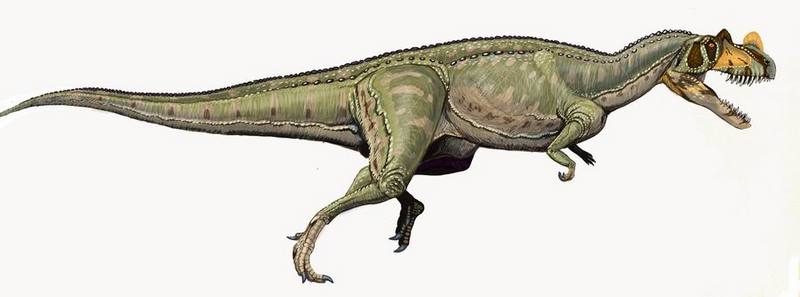Ceratosaurus - Wiki Ceratosaurus
From Wikipedia, the free encyclopedia
[Photo] Ceratosaurus_nasicornis- reconstruction autor - Bogdanov dmitrchel@mail.ru
Ceratosaurus (IPA: /s??????æt??'s??ː????s/) meaning 'horned lizard', in reference to the horn on its nose (Greek keras/keratos meaning 'horn' and sauros meaning 'lizard'), was a large predatory dinosaur from the Late Jurassic Period, found in the Morrison Formation of North America, in Tanzania and possibly in Portugal. It was characterized by large jaws with blade-like teeth, a large, blade-like horn on the snout and a pair hornlets over the eyes. The forelimbs were powerfully built but very short. The bones of the sacrum were fused (synsacrum) and the pelvic bones were fused together and to this structure (Sereno 1997) (i.e. similar to modern birds). A row of small osteoderms was present down the middle of the back.
Discovery and species
Ceratosaurus is known from the Cleveland Lloyd Dinosaur Quarry in central Utah and the Dry Mesa Quarry in Colorado. The type species, described by O. C. Marsh in 1884 and redescribed by Gilmore in 1920, is Ceratosaurus nasicornis. Two further species were described in 2000, C. magnicornis, and dentisulcatus. Both are more powerfully built, more derived, and appear in slightly younger rocks than C. nasicornis. More additional species, including C. ingens, C. stechowi and a species that has been referred to as C. meriani, from Portugal, have been described from less complete material. Ceratosaurus species:
C. nasicornis (type)
C. dentisulcatus
C. magnicornis
C. ingens
C. stechowi
C. meriani
Paleobiology
Ceratosaurus lived alongside dinosaurs such as Allosaurus, Torvosaurus, Apatosaurus, Diplodocus, and Stegosaurus. It may have competed with Allosaurus for prey, though it was smaller at around 6 to 8 meters (20-27 feet) in length, 2.5 meters (8 feet) tall, and weighing 500 kg up to 1 tonne; it would have occupied a distinctly separate niche from its larger cousin. Ceratosaurus had a longer, more flexible body, with a tail shaped like a crocodilian. This suggests that it was a better swimmer than the stiffer Allosaurus. A recent study by Bakker suggested that Ceratosaurs generally hunted aquatic prey, such as fish and crocodiles, although it had potential for feeding on large dinosaurs. The study also suggests that sometimes adults and juveniles ate together. This evidence is, of course, very debatable and Ceratosaurus tooth marks are very common on large, terrestrial dinosaur prey fossils. Another common theory is that Ceratosaurus preyed primarily on Dryosaurus, Camptosaurus, and other Ornithopoda, since it was likely a lone hunter and incapable as such of bringing down adult sauropods. Scavenging from corpses, smaller predators, and after larger ones also likely accounted for some of its diet.
Classification
Relatives of Ceratosaurus include Genyodectes, Elaphrosaurus, and the abelisaur Carnotaurus. The classification of Ceratosaurus and its immediate relatives has been under intense debate recently. Ceratosaurus is unique in its characters; it is too advanced and basal tetanuran-like to be a large, late coelophysoid; and too primitive in many manners to be a true carnosaur. Its closest relatives appear to be the abelisaurs from the Cretaceous, but again, Ceratosaurus is an enigma in its existing tens of millions of years before them with no obvious Early Cretaceous link between them.
In the past, Ceratosaurus, the Cretaceous abelisaurs, and the primitive coelophysoids were all grouped together and called Ceratosauria, defined as "theropods closer to Ceratosaurus than to Aves". Recent evidence, however, has shown large distinctions between the later, larger and more advanced ceratosaurs and earlier forms like Coelophysis. While considered distant from birds among the theropods, Ceratosaurus and its kin were still very bird-like, and even had a more avian tarsus than Allosaurus. As with all dinosaurs, the more fossils found of these animals, the better their evolution and relationships can be understood.
http://en.wikipedia.org/wiki/Ceratosaurus
| The text in this page is based on the copyrighted Wikipedia article shown in above URL. It is used under the GNU Free Documentation License. You may redistribute it, verbatim or modified, providing that you comply with the terms of the GFDL. |
